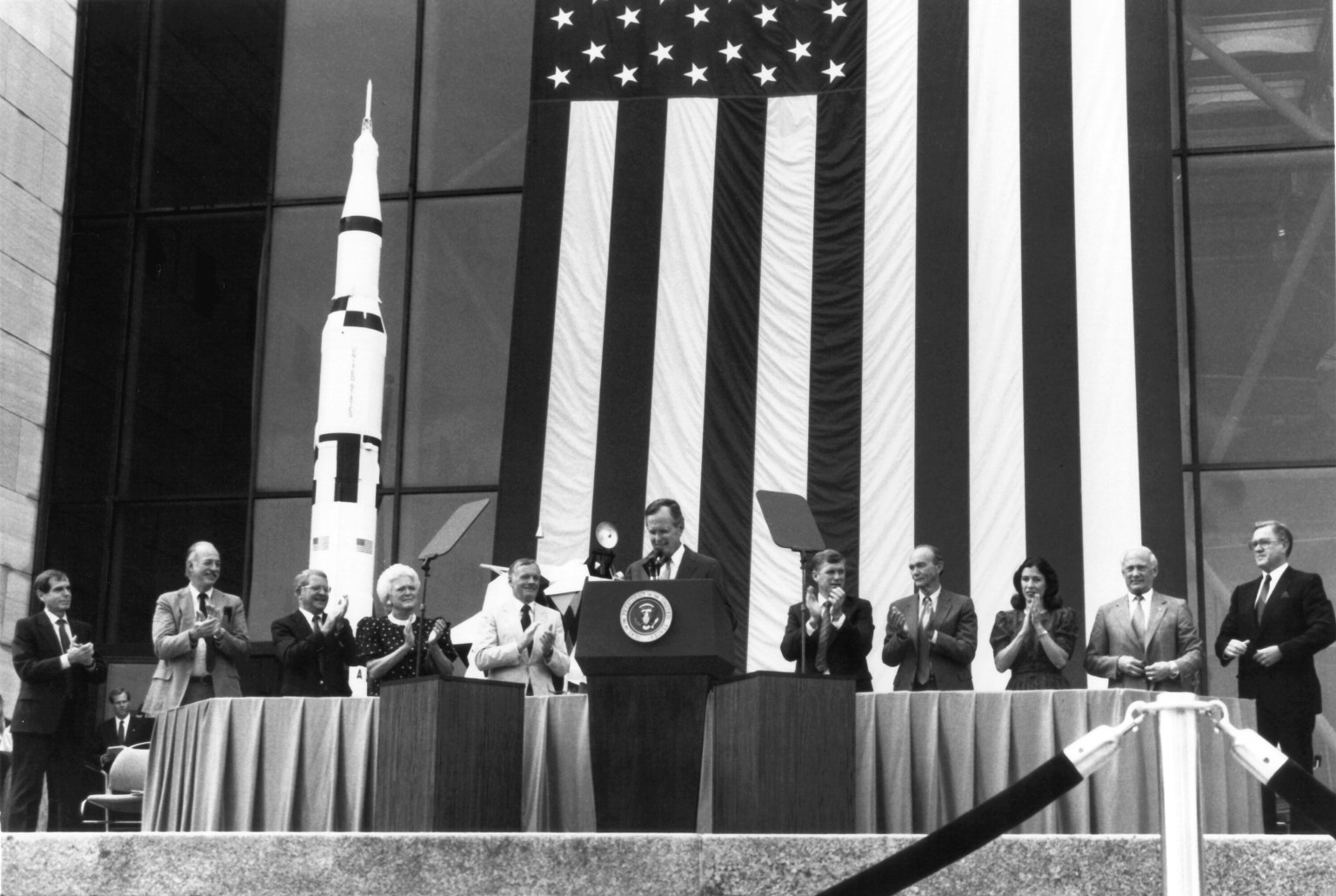[Editorial Headnote: From the Report of the Advisory Committee on the Future of the U.S. Space Program (Washington, D.C.: U.S. Government Printing Office, December 1990), pp. 47–48. Page numbers of original document in brackets.]
[47]
Principal Recommendations
This report offers specific recommendations pertaining to civil space goals and program content as well as suggestions relating to internal NASA management. These are summarized below in four primary groupings. In order to implement fully these recommendations and suggestions, the support of both the Executive Branch and Legislative Branch will be needed, and of NASA itself.
Principal Recommendations Concerning Space Goals
It is recommended that the United States’ future civil space program consist of a balanced set of five principal elements:
- a science program, which enjoys highest priority within the civil space program, and is maintained at or above the current fraction of the NASA budget (Recommendations 1 and 2);
- a Mission to Planet Earth (MTPE) focusing on environmental measurements (Recommendation 3);
- a Mission from Planet Earth (MFPE), with the long-term goal of human exploration of Mars, preceded by a modified Space Station which emphasizes life-sciences, an exploration base on the moon, and robotic precursors to Mars (Recommendations 4, 5, 6, and 7);
- a significantly expanded technology development activity, closely coupled to space mission objectives, with particular attention devoted to engines + a robust space transportation system (Recommendation 9).
Principal Recommendations Concerning Programs
With regard to program content, it is recommended that:
- the strategic plan for science currently under consideration be implemented (Recommendation 2);
- a revitalized technology plan be prepared with strong input from the mission offices, and that it be funded (Recommendation 8);
- Space Shuttle missions be phased over to a new unmanned (heavy-lift) launch vehicle except for mission where human involvement is essential or other critical national needs dictate (Recommendation 9);
- Space Station Freedom be revamped to emphasize life-sciences and human space operations, and include microgravity research as appropriate. It should be reconfigured to reduce cost and complexity; and the current 90-day time limit on redesign should be extended if a thorough reassessment is not possible in that period (Recommendation 6);
- a personnel module be provided, as planned, for emergency return from Space Station Freedom, and that initial provisions be made for two-way missions in the event of unavailability of the Space Shuttle (Recommendation 11).
Principal Recommendations Concerning Affordability
It is recommended that the NASA program be structured in scope so as not to exceed a funding profile containing approximately 10 percent real growth per year throughout the remainder of the decade and then remaining at that level, including but not limited to the following actions:
- redesign and reschedule the Space Station Freedom to reduce cost and complexity (Recommendation 6);
- defer or eliminate the planned purchase of another orbiter (Recommendation 10);
- place the Mission from Planet Earth on a “go-as-you-pay” basis, i.e., tailoring the schedule to match the availability of funds (Recommendation 5).
Principal Recommendations Concerning Management
With regard to management of the civil space program, it is recommended that:
- an Executive Committee of the Space Council be established which includes the Administrator of NASA (Recommendation 12);
- major reforms be made in the civil service regulations as they apply to specialty skills; or, if that is not possible, exemptions be granted to NASA for at least 10 percent of its employees to operate under a tailored personnel system; or, as a final [48] alternative, that NASA begin selectively converting at least some of its centers into university-affiliated Federally Funded Research and Development Centers (Recommendations 14 and 15);
- NASA management review the mission of each center to consolidate and refocus centers of excellence in currently relevant fields with minimum overlap among centers (Recommendation 13).
It is considered by the Committee that the internal organization of any institution should be the province of, and at the discretion of, those bearing ultimate responsibility for the performance of that institution. . . .
- That the current headquarters structure be revamped, disestablishing the positions of certain existing Associate Administrators . . .
- an exceptionally well-qualified independent cost analysis group be attached to headquarters with ultimate responsibility for all top-level cost estimating including cost estimates provided outside of NASA;
- a systems concept and analysis group reporting to the Administrator of NASA be established as a Federally Funded Research and Development Center;
- multi-center projects be avoided wherever possible, but when this is not practical, a strong and independent project office reporting to headquarters be established near the center having the principle share of the work for that project; and that this project office have a systems engineering staff and full budget authority (ideally industrial funding—i.e., funding allocations related specifically to end-goals).
In summary, we recommend:
- Establishing the science program as the highest priority element of the civil space program, to be maintained at or above the current fraction of the budget.
- Obtaining exclusions for a portion of NASA’s employees from existing civil service rules or, failing that, beginning a gradual conversion of selected centers to Federally Funded Research and Development Centers affiliated with universities, using as a model the Jet Propulsion Laboratory.
- Redesigning the Space Station Freedom to lessen complexity and reduce cost, taking whatever time may be required to do this thoroughly and innovatively.
- Pursuing a Mission from Planet Earth as a complement to the Mission to Planet Earth, with the former having Mars as its very long-term goal—but relieved of schedule pressures and progressing according to the availability of funding.
- Reducing our dependence on the Space Shuttle by phasing over to a new unmanned heavy lift launch vehicle for all but missions requiring human presence.
The Committee would be pleased to meet again in perhaps six months should the NASA Administrator so desire, in order to assist on the implementation process. In the meantime, NASA may wish to seek the assistance of its regular outside advisory group, the NASA Advisory Council, to provide independent and ongoing advice for implementing these findings.
Each of the recommendations herein is supported unanimously by the members of the Advisory Committee on the Future of the U.S. Space Program.































